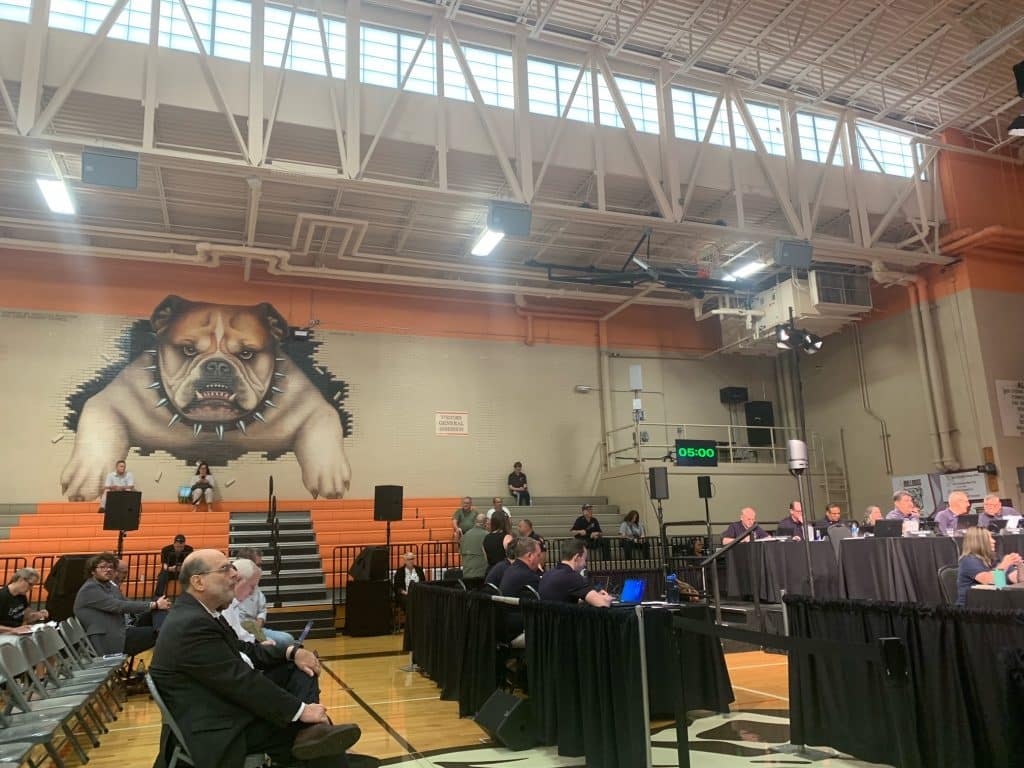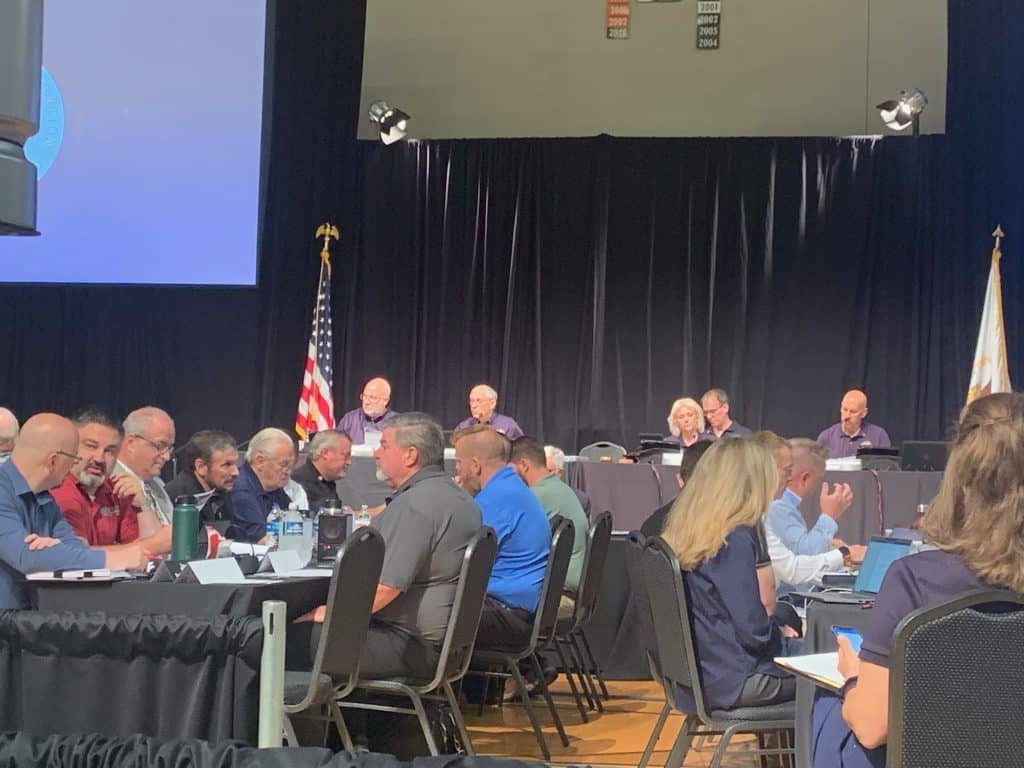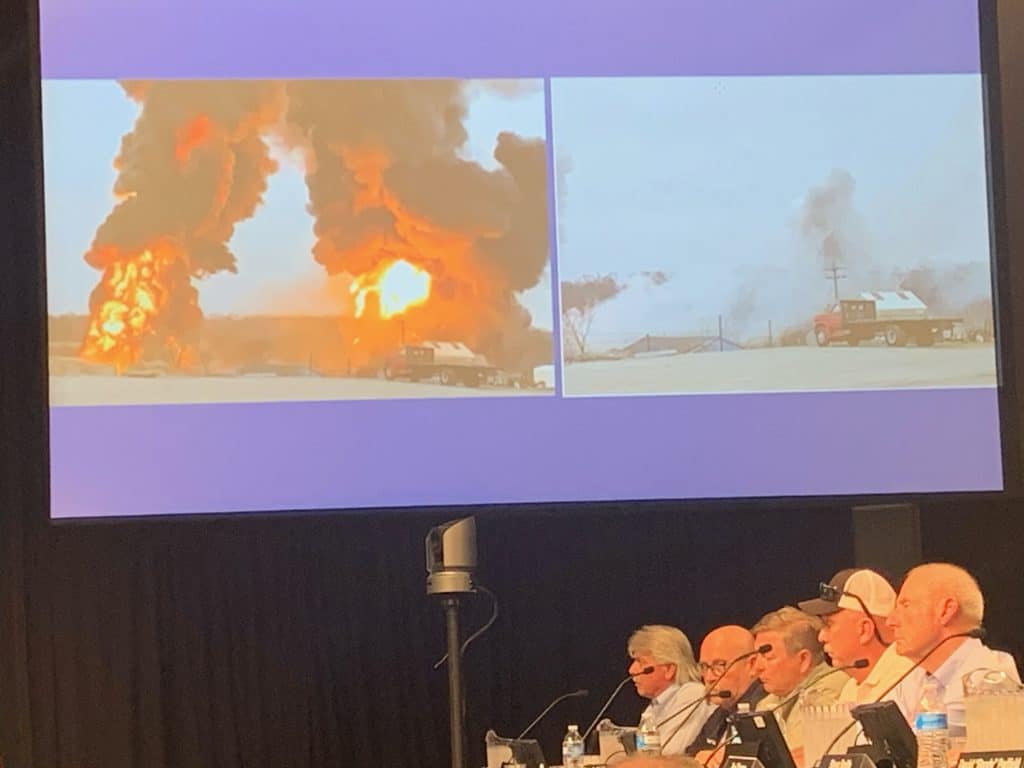
During the first day of the National Transportation Safety Board (NTSB) hearing on Norfolk Southern’s East Palestine, Ohio, derailment that happened Feb. 3, the importance of sharing information and communications in the wake of a rail disaster was brought into clear focus.
For an industry that says that data, hard evidence and the collection of information are major guiding principles for its decision-making process when people’s careers and the bottom line are at stake, the indications are carriers can do a much better job of putting first responders and everybody else in the loop when communities and lives are at stake in such a situation.
After all, it’s the train crews, fire crews, the EMS and the police in the places where accidents happen that are at risk in a disaster of the scope of East Palestine. Their resources are the ones that are expended and stressed to the limit by a billion-dollar corporation that’s passing through.
But talks of communication gaps abounded during testimony on June 22.
The crew had information responders could have used
One key commonality to many of the communication breakdowns is that the N32’s conductor was kept at arm’s length. As it was stated in the hearing, the conductor and his trainee had the train consist on the engine. Railroaders know that this document should have provided much-needed clarity to first responders as they put together their plan of attack.
In the hearing it was discussed that the railroad took hours to respond to the incident command center’s request for the consist information. They wanted this document so that they could determine if an evacuation was necessary, if so how large of an area would need to be evacuated, what chemicals were involved with the derailment, and what the proper tactics were to triage the fallout from these chemicals being on fire. All of these items and knowledge are held by the conductor, their paperwork and the Emergency Response Guide (ERG).

Ironically, the problem the command center cited as to why they didn’t have communications with the crew/conductor, is that they had separated the locomotive and moved it a mile away. They did this because they had quickly and professionally used the resources at their disposal to calculate what chemicals they were hauling and that the ERG prescribed one mile of separation from the scene. This was the correct diagnosis, and the crew figured it out quickly. As the command center scrambled and struggled to figure out what to do, the crew already had figured it out, and acted upon it.
As the employee in charge of the train consist, N32’s conductor had all the information necessary to determine the correct course of action, as well as all the contact information needed to get a hold of the shippers and manufacturers of the chemicals. This information should have directly connected the first responders to the subject matter experts. A fire chief, police officer or even the governor of Ohio had no reason to know what a conductor’s role should be in that scenario.
Norfolk Southern, however, has every reason to know that the crew was the missing link that could have closed the communication gaps that plagued the response to the disaster. With as many people and vehicles that responded to the derailment and chemical release, it’s not unreasonable to think someone could have driven the one mile to the locomotive to check the crew’s status and to obtain the consist. If nothing else, someone could have contacted them over the radio to at least ask them what they based their decision on to get the locomotive exactly one mile away from the scene. What they would have learned is that the crew’s conductor and trainee didn’t choose that distance at random and they used the exact criteria that the command center should have been consulting to determine the “one-mile” radius needed for a proper evacuation.
More communication gaps
Oxy Vinyls, the subject-matter experts of the vinyl chloride contained within the tank cars ultimately subjected to the “vent and burn,” had representatives present and available to discuss what they thought was occurring in East Palestine. Though they had an expert on-site to discuss the chemical’s components and likely behavior, much like the train’s conductor their expert was not incorporated into the central command emergency response group. They had just one brief interaction with East Palestine Fire Chief Keith Drabick, head of the central command, as the response effort was unfolding and were directed to NS representatives.
From then on, NS and its contractor acted as a buffer between the expert from Oxy Vinyls and Chief Drabik in his role as head of the incident command center.
It wasn’t just the fire chief of the imperiled town of 4,500 who didn’t have all the information the carriers and its contractors did. The offices of Ohio Gov. Mike DeWine and Pa. Gov. Josh Shapiro weren’t told key bits of information that may have changed their response to resolving the situation, testimony revealed.

The day after the wreck, on Saturday, the conclusion had been reached that a “vent and burn” was the best option to proceed. The polymerization of the vinyl chloride inside a tanker was cited along with tanker damage as a motivator. Oxy Vinyls representatives in their testimony indicated that the temperature readings did not indicate that polymerization was occurring. They also gave testimony that heat alone cannot cause the polymerization feared by incident command, saying oxygen had to be present in the tank car to make that process possible. This was seemingly not the case because even though their five tank cars had been dented in the derailment, none of them had been penetrated, and the self-sealing pressure release valves were performing as intended.
The “vent and burn” that unleashed a black cloud over the small community on the Ohio-Pennsylvania border seemed over reliant on gut instincts and the field experience of the contractors paid to perform it rather than data, science and on-site resources. It also saved time — the alternative “hot tap” would have taken more time while the vent-and-burn procedure takes hours. By the contractor’s estimate, the “hot tap” solution to the problem would have taken at least five days to complete which would have been inconvenient to the goal of moving freight through southeastern Ohio.
As it happened, the positive for NS was that the “last resort” got the trains going faster while leaving a black cloud over East Palestine. From what the NS spokesman on the panel testified, the decision to conduct the “vent and burn” process was brought on by the fact that the temperature readings on one of the cars had elevated 3 degrees Fahrenheit from 135° F to 138°F.
What was pointed out in the hearing and was seemingly previously unknown to Chief Drabick was that in the time it took to prepare the five cars for the vent-and-burn procedure, the car in question was steadily dropping in temperature. By the time the vent and burn was executed, the temperature had dropped 12 degrees Fahrenheit to 126°F. This drop in temperature was 4 times the increase in temperature that triggered the decision to take that step; however, this drop in temperature was seemingly not brought to the attention of Drabick or the two involved governors.
SMART-TD Alternate National Legislative Director Jared Cassity, who represented our union at the hearing, asked the contractors if once they had decided to go ahead with the vent and burn if it would have been possible to backtrack in light of the information about the falling temperatures of the cars. They said that it was indeed a possibility to have changed course right up until the process was initiated.
Members of the East Palestine community who were in attendance, along with Chief Drabick himself, seemed to be confused and shocked at the answer to Cassity’s question.
Another example of gaps in the communication within the incident command was that the Ohio National Guard who was charged with the duty to determine and initiate the mandatory evacuation of the community gave testimony that it was their understanding that they were preparing the community of East Palestine for an emergency evacuation consistent with the venting and burning of a single car of chemicals. On the day of the vent and burn they found out at the 11th hour that the intent was to vent and burn five cars. All the decisions made by the Ohio National Guard on the size of the evacuation zone and the staffing to support it were already baked into the cake by the time they were made aware the plan had expanded.
Maj. Gen. John Harris, Jr. was the representative of the Guard on Thursday’s panel and gave the details of how he and the Guard were caught off guard by this pivotal piece of information.
The picture that came into focus during the testimony of how the derailment was handled and the decision made to vent and burn the material in the five tank cars of vinyl chloride was not flattering for NS and its contractors with preventable communication gaps among members of incident command resulting in a black cloud over the response tactic chosen, as well as over a community that will take years to recover.
Panel discussions 3 and 4 were held Friday, June 23, and featured discussions focused on wheel bearings, wayside defect detectors, car inspection practices, and the construction and classification of tank cars. A recap of what occurred on the second day will be published soon.
Related News
- Santa Monica Local Wins Cost of Living Increases
- UTUIA is now American Journey Financial Life (AJFL)
- Senate Hearing Indicates Trouble for Public Transportation
- REMINDER: Registration Open for Anaheim Regional Training Seminar
- 2025 National Agreement Freight Negotiations Update from President Ferguson
- Brother Bill Link Retires After a Memorable 53 Year Career
- Bad Actors to be Restrained Thanks to New SMART-TD-backed Transit Bill
- Nebraska Reforms Standards for Rail Crew Transportation
- Show Your Pride, Win Shirts for Your Entire Local
- Where Do You Get Your News? Help SMART-TD Meet You There